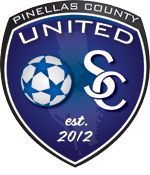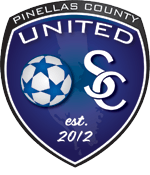LIGHTNING AND SEVERE
Weather Policy
Our goal is to practice and play anytime it is safe to do so. Extreme heat / cold temperatures, lightning, and rain, can put our players, coaches, and spectators at risk. For your safety and those around you, please review and be familiar with our inclement weather policies below.
Environmental conditions can significantly impact player health and safety. Extreme temperatures, severe weather and the integrity of the playing field and its equipment all impact players’ ability to practice and compete safely. U.S. Soccer’s Recognize to Recover program gives players, parents, coaches and referees information and guidelines to make sure the desire to play does not cloud the decision-making process when it comes to evaluating environmental conditions to ensure the safety of those on the field.
Inclement Weather
Player safety on and off the field is our priority, and we use a catalog of resource to help inform our decisions to adapt to weather changes, suspend, and/or cancel when needed. A few resources include:
US Soccer’s Recognize to Recover has guidelines to protect players related to heat, cold temperatures, on-field conditions, hydration, lightning, sun protection and more.
Lightning is one of the top ten causes of sudden death in sport.1 As the majority of soccer is played outdoors, lightning and severe weather pose a threat to player health and safety. U.S. Soccer’s Recognize to Recover program, with the help of the Korey Stringer Institute, provides these guidelines for responding quickly and safely when lightning and severe weather threaten practice or a game. When it comes to making decisions to suspend or cancel play due to weather condition, coaches, officials, athletic trainers and administrators all share responsibility. These same individuals should be aware of close safe shelter locations and know how to evaluate when it is safe to resume play after severe weather leaves an area.
Casa DJ, Guskiewicz KM, Anderson SA, et al. National Athletic Trainers’ Association Position Statement: Preventing Sudden Death in Sports. J Athl Train. 2012;47(1):96-118.
When should activities be stopped?
Information provided from National Weather Service click here to view there page.
In general, a significant lightning threat extends outward from the base of a thunderstorm cloud about 6 to 10 miles. It’s important to account for the time it will take for everyone to get to safety. Here are some criteria that could be used to stop activities.
- If you see lightning. The ability to see lightning varies depending on the time of day, weather conditions, and obstructions such as trees, mountains, etc. In clear air, and especially at night, lightning can be seen from storms more than 10 miles away provided that obstructions don’t limit the view of the thunderstorm.
- If you hear thunder. Thunder can usually be heard for a distance of about 10 miles provided that there is no background noise. Traffic, wind, and precipitation may limit the ability to hear thunder to less than 10 miles. If you hear thunder, though, it’s a safe bet that the storm is within ten miles.
- If the skies look threatening. Thunderstorms can develop directly overhead and some storms may develop lightning just as they move into an area.
RECOGNIZE
- No place outside is safe when thunderstorms are in the area. All activity should be suspended, even if lightning or thunder has not yet been observed, and everyone should get indoors. Communicate this information completely and quickly to all participants.
- Consult the National Weather Service, the Storm Prediction Center or local media outlets for severe weather watches and warnings. Alerts can even be sent directly to your mobile device while you are on the field.
- Safe locations should be available with enough capacity to hold all who may need safe shelter. A primary location would be a fully enclosed building with wiring and plumbing. A fully enclosed vehicle with a solid metal roof, like a school bus, would be a safe secondary option. Open fields and open-sided shelters are not safe. If there are no adequate safe shelters close to the field, play must be stopped well in advance of the storm to allow everyone to travel to a safe place or their home.
- If it’s been half an hour since thunder, it’s safe to go outdoors. Outdoor activity may resume 30 minutes after the last sound of thunder or flash of lightning. The 30-minute clock restarts every time lightning flashes or thunder sounds. The coaches or staff can use weather bug, ThorGuard or any other app but it will not over ride the 30 minute requirement set by US Soccer.
RECOVER
If someone is injured by a lightning strike, follow these emergency management steps:
- Call 911 and alert emergency medical responders (EMS).
- Establish that the area is safe before moving to help victim. If there is more than one victim, first assist those who appear in the most severe condition.
- Move individual(s) carefully to a safe location (victims of lightning strikes are safe to touch and do not carry an electric charge).
- Initiate CPR on victims who are unconscious, not breathing or have no pulse. Use an automated external defibrillator (AED) if one is available.
- Evaluate the individual(s) for additional injuries, such as broken bones or dislocations. Notify EMS of the potential injuries when they arrive on the scene.
Under no circumstances should a player injured in a lightning strike return to the game or practice. Injured players should only be allowed to return to play after a thorough examination and release by a qualified physician.
Warning signs of a lightning strike:
- Feeling the hair stand on end
- Skin tingling
- Hearing crackling noises
If these occur, assume the lightning safe position:
- Crouch on the ground as low as you can
- Put all your weight on the balls of your feet
- Keep your feet together
- Lower head and cover your ears
- Do not lie flat on the ground
Provided AYSL/PCU allows for games to continue, the referees make the final decision on whether the conditions are safe or not for play at the game.
Inclement Weather Communication
Our goal is to communicate cancellations as soon as a decision is made, and we strive to make a decision by 4pm during the week and 6:30am on the weekend. This affects carpool schedules and long commutes so we will do our best to stick to this schedule.
We often wait until these times to make a decision in hopes conditions will improve and allow us to play. Most of our rented fields are governed by other entities (e.g., City of St Petersburg, City of Pinellas Park) who determine whether fields are open or closed and these entities often do not inform us of field decisions until after 3:30pm.

We rely primarily on PlayMetrics to communicate cancellations or any weather related information. Each program director is in charge of relaying the information to the appropriate families. Please be sure to have your PlayMetrics email and text notifications turned on to receive alerts as soon as cancellations or delays are sent.
Field Status
We update the field status on this website as soon as a decision is made. Fields are marked “closed” if weather conditions are not safe for players, and we cancel soccer related activities. No one is allowed to play on a “closed” field.




